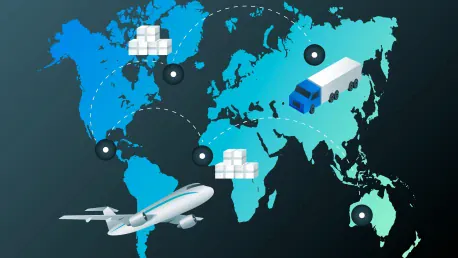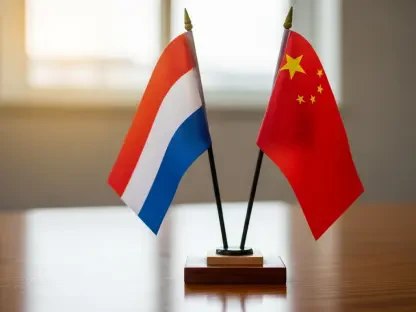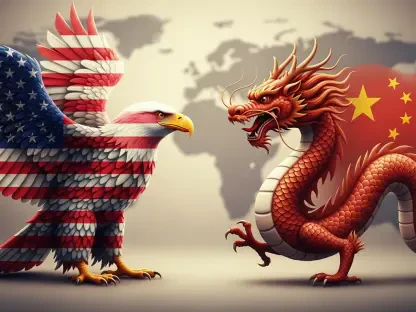A political savant and leader in policy and legislation, Donald Gainsborough is at the helm of Government Curated. In today’s conversation, we delve into the intricacies of U.S.-China trade tensions, exploring the impacts and responses spurred by President Trump’s tariff strategy, China’s reactions, and the broader global repercussions.
How has President Trump’s tariff strategy impacted the current state of trade between the U.S. and China?
President Trump’s tariff strategy has significantly strained trade relations between the U.S. and China, escalating a trade war that has seen tariffs rise dramatically. This approach, aimed at addressing trade imbalances and protecting American industries, has led to increased costs for importers and exporters, impacting various sectors from manufacturing to consumer electronics. The retaliation from China has also intensified, creating uncertainty and volatility in the global market.
Can you explain the increase in tariffs from the initial 34 percent to the current 145 percent on Chinese imports?
The tariff rates on Chinese imports were initially set at 34 percent as a measure to address trade imbalances and encourage fair trade practices. However, as negotiations failed to yield the desired outcomes and trade deficits continued, the Trump administration progressively increased tariffs. The current rate of 145 percent reflects ongoing efforts to pressure China into making concessions and implementing changes that the U.S. deems necessary for equitable trade.
What specific American goods are affected by China’s 125 percent retaliatory tariffs?
China’s retaliatory tariffs target a wide range of American goods, including agricultural products like soybeans, pork, and dairy. These tariffs also impact industrial goods, automobiles, and various manufactured products. The goal is to exert pressure on American exporters and industries that heavily rely on the Chinese market, thereby hitting back at the U.S. for its initial tariff impositions.
Why did China decide to halt exports of rare earth minerals and magnets, and what impact has this had on industries like semiconductors and auto manufacturing?
China’s decision to halt exports of rare earth minerals and magnets is a strategic move, as these materials are crucial for high-tech industries, including semiconductors and auto manufacturing. This halt has caused significant supply chain disruptions, leading to production delays and increased costs for companies reliant on these materials. The move underscores China’s leverage in the global supply chain, particularly in sectors dependent on advanced technology components.
The Trump administration announced that smartphones and other electronics would be temporarily exempt from tariffs. Can you elaborate on why this exemption was made and how long it is expected to last?
The exemption for smartphones and other electronics was likely made to mitigate the immediate impact on consumers and retail markets, as these products are essential and widely used. This move also acknowledges the interconnected nature of global supply chains, where American tech companies depend on Chinese manufacturing. The temporary nature of this exemption suggests it is a tactical decision, providing some relief while negotiations continue, but the duration remains uncertain as future tariffs could still be imposed depending on the progress of trade talks.
Treasury Secretary Scott Bessent mentioned the U.S. is in talks with China’s neighbors, including Vietnam. What progress has been made in these discussions?
Negotiations with China’s neighbors, including Vietnam, have focused on strengthening trade ties and diversifying supply chains to reduce dependency on China. Progress includes exploring new trade agreements, enhancing collaboration in key industries, and improving market access. These efforts aim to create a more balanced and resilient regional trade network, which could provide alternatives to reliance on Chinese imports and exports.
How are the ongoing trade tensions between the U.S. and China influencing the global economic environment and international relationships?
The trade tensions between the U.S. and China have created ripples across the global economy, leading to increased market volatility, shifts in trade patterns, and economic uncertainty. Countries and companies are re-evaluating their supply chains and seeking new trade alliances to mitigate risks. The tensions also strain diplomatic relations, as nations are often compelled to navigate their stances carefully to avoid being caught in the crossfire of the world’s two largest economies.
In his letter, President Xi highlighted the importance of a multilateral trading system and an inclusive economic globalization. Can you explain what he means by these terms?
President Xi’s reference to a multilateral trading system emphasizes the importance of international cooperation and adherence to global trade rules, typically embodied by organizations like the WTO. An inclusive economic globalization means ensuring that the benefits of global trade and economic growth are broadly shared among nations, reducing inequality and fostering a more balanced economic development. These concepts stress collaboration over confrontation and mutual benefit over protectionism.
What are the primary goals of China’s visit to Vietnam, and what does China hope to achieve from this diplomatic mission?
China’s visit to Vietnam aims to strengthen bilateral ties, enhance economic cooperation, and solidify regional partnerships. By deepening relations with Vietnam, China hopes to secure strategic alliances, increase influence in Southeast Asia, and find new markets for Chinese exports. This visit also serves as a platform to showcase China’s commitment to regional stability and economic growth, countering the narrative of trade conflict with the U.S.
How is China working towards building a modern socialist country and achieving national rejuvenation, as referenced by President Xi in his letter?
China’s approach to building a modern socialist country involves fostering economic innovation, upgrading industrial capabilities, and improving living standards. This vision includes significant investments in technology, infrastructure, and education. National rejuvenation refers to reviving China’s historical influence and achieving a prominent global status through sustained economic growth, cultural resurgence, and strategic diplomacy.
What strategies is the Trump administration considering to resolve the trade deficit with China?
The Trump administration is employing several strategies to address the trade deficit, including imposing tariffs to protect domestic industries, negotiating trade agreements with other countries to diversify markets, and encouraging companies to repatriate manufacturing to the U.S. These measures are designed to reduce dependency on Chinese imports, boost American exports, and ultimately create a more balanced trade environment.
Can you describe the implications of ongoing trade disputes on both American and Chinese consumers and businesses?
The trade disputes have resulted in higher prices for consumers due to increased tariffs on imported goods, affecting everyday items and eroding purchasing power. For businesses, the disputes have led to rising production costs, supply chain disruptions, and uncertainties in market conditions. In both the U.S. and China, these factors have prompted companies to reconsider their sourcing strategies, potentially relocate operations, and explore new markets to mitigate the impact of the trade tensions.
Do you have any advice for our readers?
In these turbulent times of global trade uncertainty, it’s crucial to stay informed and adaptable. Whether you’re a consumer or a business owner, understanding the dynamics of international trade can help you make more informed decisions. Diversifying sources, keeping an eye on policy changes, and being open to new markets and opportunities can enable better navigation through these complex economic landscapes.









